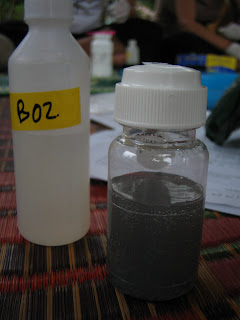 For 3 days, we headed to the countryside to work with Mickey and the RDIC gang on sustainable development projects. Rice-husk latrine, anyone? This is the same organization we worked with for Golden Week for our rainwater collection unit, and they are jaw-droppingly amazing. However, the certainty of rain makes building concrete tanks problematic in August, so we worked on other projects. Everyone who has ever met Mickey wants to marry him, and it took about 10 minutes for most of us to agree. He's sort of magical-- the type of person who starts explaining a complex issue and when he finishes, you'd like to believe that's what you'd been thinking in your head all along. He's a funny, charming, family man from Kentucky and everyone at RDIC is doing really great work. They do everything from water testing to well-building to health education to animal husbandry to karaoke/media presentations to tree grafting to fish-raising using goat manure runoff to feed the algae which feed the fish... I could go on. The goat pen also featured the biggest stud I've ever seen in my life. He was the size of an oxen with gigantic horns and I was terrified. RDIC offers a 2-for-1 goat exchange, where they give 2 goats, offering stud service for free, and get one back in exchange. I miss my goat babies.  Our time there was fun, but a bit inefficient in terms of how much was accomplished and how much time we waited around. It's hard to have groups of volunteers show up without specific skills who really want to help in any way they can, but there isn't always something convenient or useful to be done. We did have a good outing to a village across the river, where we visited some families' homes and tested their water for arsenic.  Arsenic is a common contaminants in the river delta area and excessive ingestion leads to arsenicosis. A visible symptom is hyperkeratosis of the skin, especially on the hands and feet, which looks like big black spots. The effects are irreversible and can lead to liver and other organ failure. In the body, it can substitute for phosphorus, causing many of these health problems. Many of the pumps in this region were installed by development or charity groups, but the water cannot be used for drinking. RDIC is researching effective ways to remove the arsenic, or else install wider, shallower wells that do not bring up water with the higher levels of the toxin. Da (above) was our main guide for the day, though he usually works in the lab instead of doing village visits. He took DJ to the village volleyball game that night. It turns out that the tall, athletic foreigner (and, shhhhhhhh, part-time model) didn't stand a chance against the buff, hardcore Khmer volleyball men.  We collected samples and tested for arsenic levels, which will be used to create a map of the country to find safe and unsafe well locations. Catherine and I were the science nerds, and even this uber-simple reaction made me almost miss chem lab. Almost. It was a little strange to be just walking into people's homes, taking water samples, playing with the kids, and then coming back to say that their water was dangerous to drink, but apparently our presence as foreigners helps legitimize the work of the Cambodian staff. Very strange. We had a whole gang of kids following us, and were able to get a good game of PET-bottle baseball going by the end of the afternoon. Our last morning was back at the RDIC factory again, painting liquid silver on water filters and getting dirty in the garden with hoes. Ah, how the "Where's your hoe?"/ "She's over there!" joke never gets old. |

